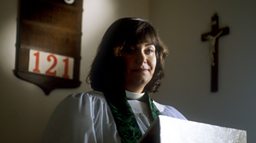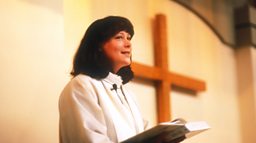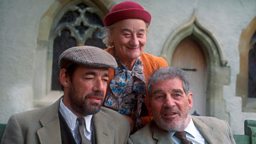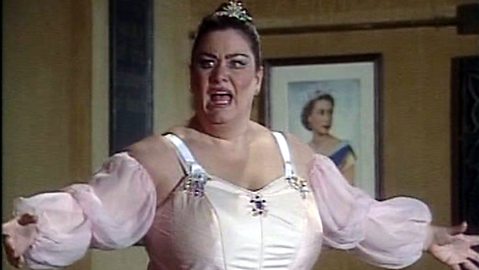Hysterical Clericals: What鈥檚 So Funny About The Vicar of Dibley?
The number of sitcoms that are mainstream, critically lauded and watched by millions across generations are few and far between. Shows such as The Royle Family, Dinnerladies and Car Share manage to magically hit the sweet spot between genuine laughs and a dedicated viewership. Another prime candidate for this esteemed company is the beloved 91热爆 One comedy classic The Vicar of Dibley. But what were the ingredients that made the show so special? TV veterans Peter Fincham and Jon Plowman (the show’s producer) were joined by the vicar herself Dawn French and the show’s creator Richard Curtis to delve into the programme’s secret formula.
-
![]()
What's Funny About... The Vicar of Dibley
TV veterans Peter Fincham & Jon Plowman talk to Dawn French and Richard Curtis and hear the inside story of bringing The Vicar of Dibley to our screens.

It was grounded in reality
Richard Curtis was characteristically humble about the origins of the Vicar of Dibley. He claimed he attended the wedding of two friends which was presided over by a female administrator and thought ‘this is so right’. In 1992, just as Richard was devising the series, the Church of England was allowing the ordination of women for the first time. He was also living in a Dibley-like village at the time and knew that it would be the perfect setting.
Geraldine's niceness was tempered
Dawn French worried about the main character of Geraldine Granger being too nice. Many classic sitcoms, such as Blackadder and Fawlty Towers, revolved around a lead that was rude and uncompromising.

But show creator Richard Curtis plugged many of Dawn’s own characteristics into the vicar’s personality. He also made sure she had some very unclerical passions such as her love of chocolate, her fondness for a tipple and her occasional, unabashed, carnality.
show creator Richard Curtis plugged many of Dawn鈥檚 own characteristics into the vicar鈥檚 personality. He also made sure she had some very unclerical passions such as her love of chocolate, her fondness for a tipple and her occasional, unabashed, carnality.
Her character came from a real place
Another way Richard convinced Dawn to join the Dibley family was introducing her to the show’s religious advisor and one of the first Anglican woman priests: Joy Carroll. When Dawn saw Joy in action in the pulpit, she realised that a vicar could have humour and personality. Joy was cheeky, rude and fun-loving; characteristics that Geraldine later adopted.
It was mainstream with an edge
One thing that allayed Dawn’s fears about the niceness of Geraldine was the anarchic streak that ran through the show. The notion of women vicars was a new and controversial one in the early 1990s, ensuring a deluge of angry letters. While characters such as Jim and Owen would often inject a substantial dose of smut into proceedings, making sure the niceness wasn’t too overwhelming.
It dealt with the British condition
Richard Curtis stated that the show dealt with a fundamental aspect of the British psyche. Namely the phenomenon of desperately attempting to maintain our niceness in highly embarrassing situations. This coupled with the established comedy trope of formal settings being hijacked by informal behaviour provided the fundamentals for the series.
It messed with sitcom conventions
Though on the surface, The Vicar of Dibley appears to be as traditional as it comes - the tale of a nice vicar in a quaint English village - but it did mess around with the conventional elements of sitcoms on occasion. For instance, it’s often the older characters in the show, such as Owen or Letitia, that have the most outrageous lines which the younger Dibley inhabitants, like Alice and Hugo, are shocked by.
Casting was everything
Richard learned during the making of his film Four Weddings and a Funeral, that you can’t underestimate the power of casting. He said that the director of that film, Mike Newell, would spend days and days trying to find the perfect person to play a bit part with hardly any lines. Curtis carried over this approach to Dibley, ensuring they had the dream line-up of actors to play the eccentric array of village characters.

Sketch writing was a vital apprenticeship
Richard Curtis started his comedy writing career producing material for his friend Rowan Atkinson and later writing sketches for shows such as Not The Nine O’Clock News. This sketch work was the ideal training for his later television and film writing, claiming Four Weddings and a Funeral is just “10 sketches stuck together” and famous Dibley set pieces, such as Alice’s wedding vows, were really just a sketch in hiding (though he also admitted his co-writer Paul Mayhew-Archer came up with that one).
It was a family affair
Both Richard and Dawn remarked on the happiness throughout the set during the making of the show. Rather than being just a job, it was a chance for a group of friends to reconnect every year. The opposite experience, so Curtis claimed, of making his other hit sitcom Blackadder. There was talk of expanding the show and making many more episodes by using an American style writers room, but no one on the team wanted to alter the chemistry that made the show so special.
The character is iconic
Like all great sitcoms, the most important factor in its success is the characters. And in Geraldine, Richard and Dawn created an unforgettable figure beloved by millions. She had her foibles and her weaknesses, coupled with an unrelenting drive to do good. And it occasionally led to some pretty strange gigs. Dawn recounted having to make a surprise appearance as the vicar at the leaving party for a British Airways employee. Her fee was free tickets for Concorde.

Dibley V Darcey
The Vicar exchanges her robe for a tutu.
More comedy from Radio 4...
-
![]()
What's Funny About... The Vicar of Dibley
TV veterans Peter Fincham & Jon Plowman talk to Dawn French and Richard Curtis and hear the inside story of bringing The Vicar of Dibley to our screens.
-
![]()
You could've made it up: the best spoof shows ever
Poke holes in preposterous behaviour - some of our favourite spoofs and parodies.
-
![]()
The Ultimate Cult Comedy Quiz
Test your knowledge of some great cult comedies from the nineties and noughties.
-
![]()
Comedy of the Week
Brighten your week with the latest 91热爆 Radio 4 comedy, introduced by Darren Harriott.




